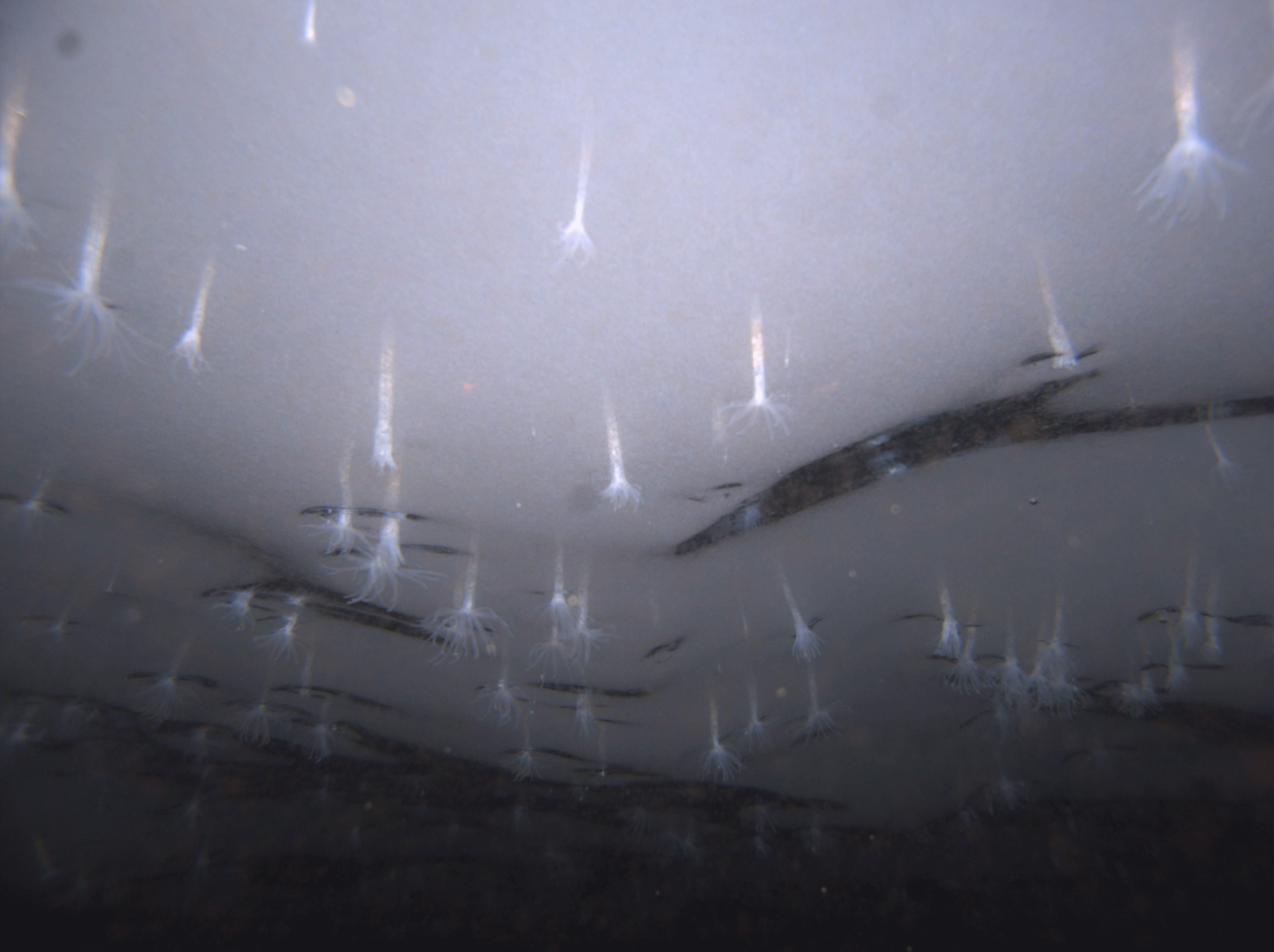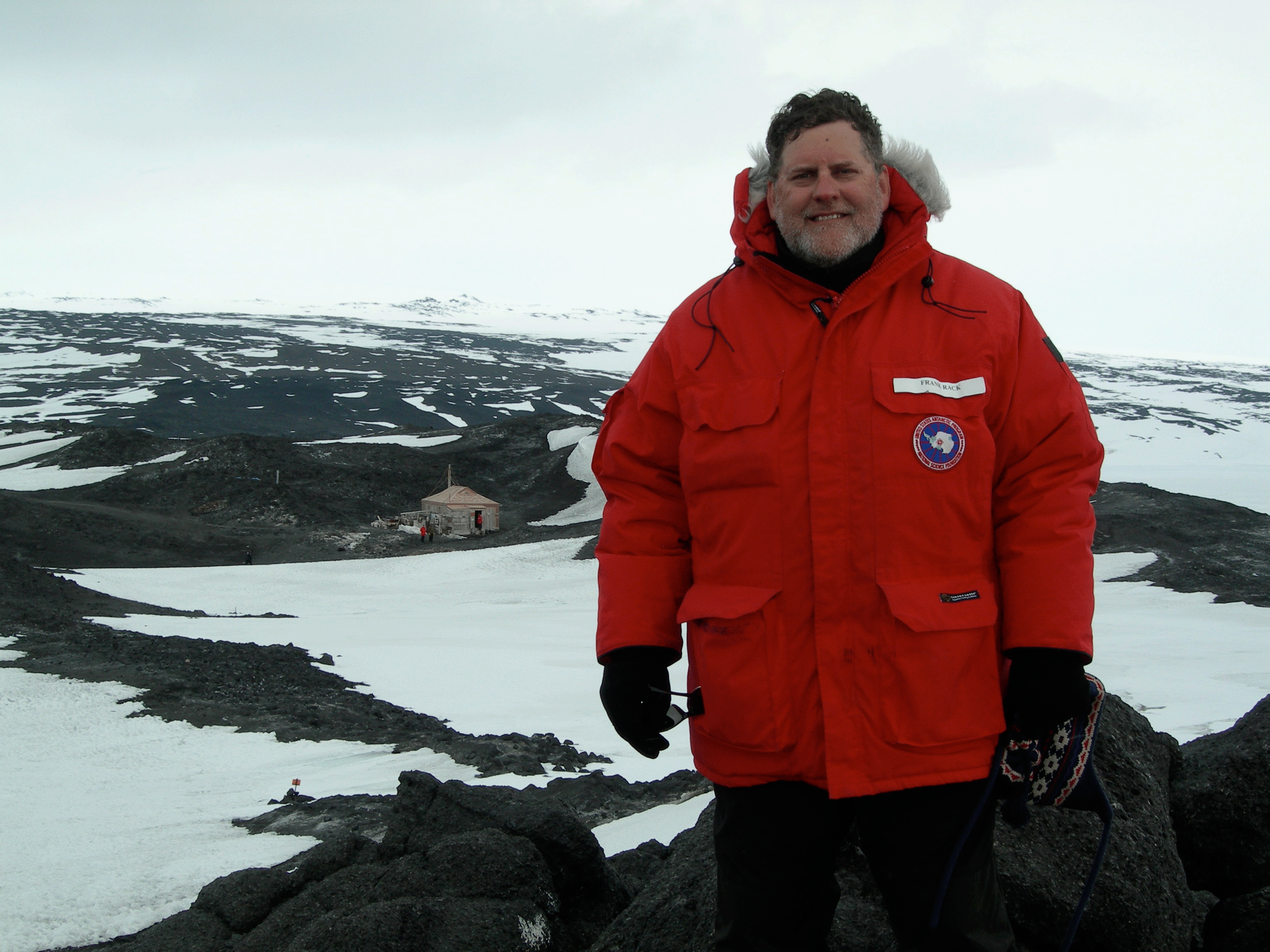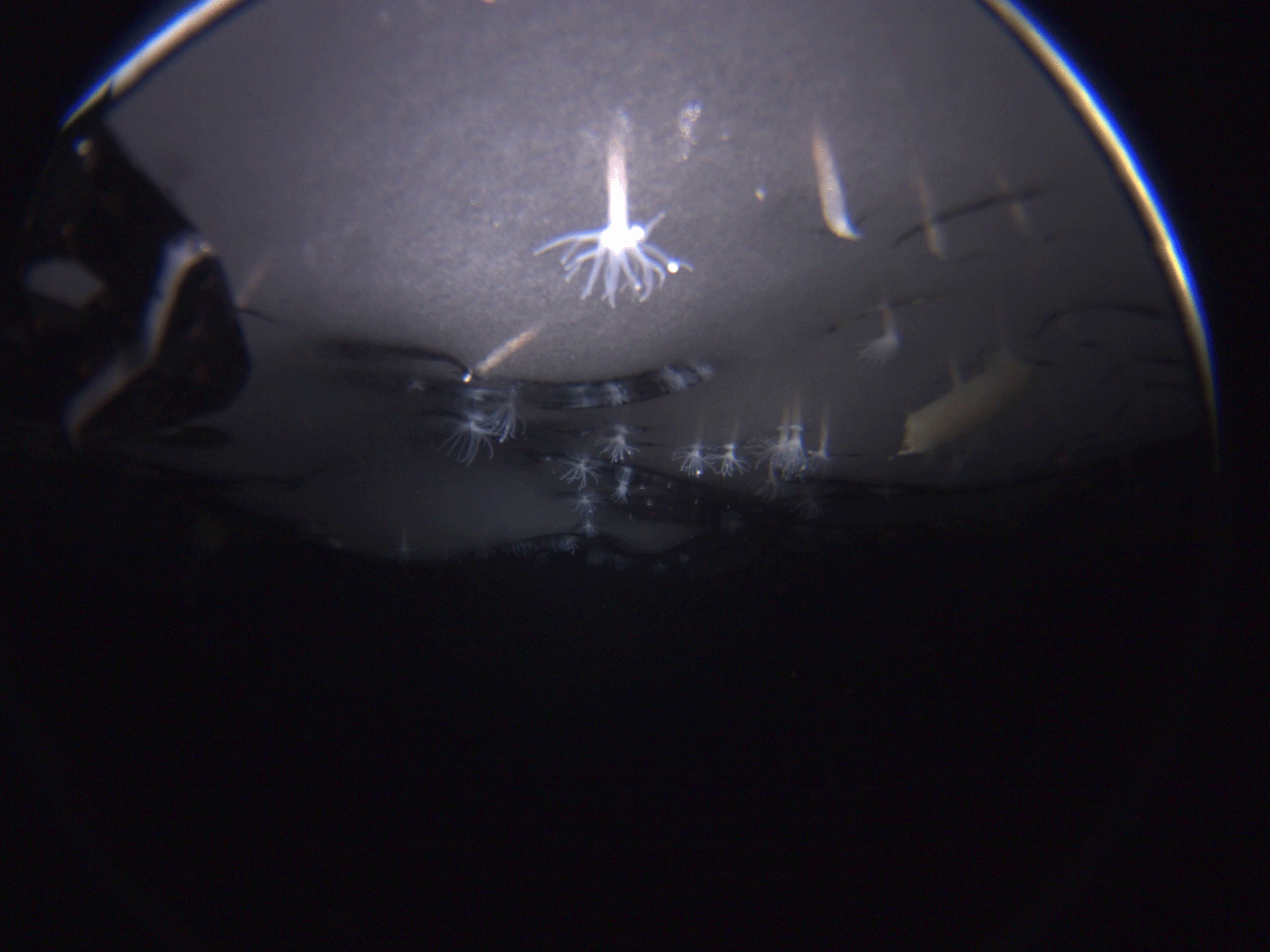New Species Discovered Under Ice
Air Date: Week of April 11, 2014

An underwater picture of the sea anemones. (Photo: Frank R. Rack, ANDRILL Science Management Office, University of Nebraska-Lincoln)
Under the Antarctic ice lurk newly discovered sea anemones. Frank Rack, Executive Director of the U.S. Antarctic Geological Drilling team, tells host by Steve Curwood about how the team discovered this new species that hangs upside down from the Ross Ice Shelf.
Transcript
CURWOOD: Now we turn from very sick sea creatures to mysterious and newly discovered ones. A team from ANDRILL, that's the Antarctic Geological Drilling, has discovered a new type of sea anemone, while testing a remotely operated vehicle under the Ross Ice Shelf off Antarctica. The researchers are geologists and sedimentologists. The director of the team is Frank Rack from University of Nebraska.
RACK: We were melting holes through the 270 meters of ice. We were deploying oceanographic sensors to measure current speed and direction. We were taking sediment cores, and we were also deploying the underwater robots to look underneath the ice and do an engineering test of the robot because it was the first time it was deployed through that thickness of ice shelf.
CURWOOD: And let’s see. The amount of ice you’re drilling through...it’s the equivalent of an 80-story office tower or something like that?
RACK: It’s something like that, yes.
CURWOOD: That’s a lot of ice.

Frank Rack in Antarctica. (Frank R. Rack)
RACK: It is a lot of ice.
CURWOOD: So, how long did it take you to find sea anemones down there?
RACK: It was a total surprise. We melted a hole through the ice, and we had been running a camera down to the sea floor and back up. And in those observations, the ice shelf looked plain and featureless, but when we put down the robot and had more sensitive camera systems and could get very close to the bottom of the ice, that’s where the anemones appeared. They were quite numerous and widespread, and they were living in burrows in the bottom of the ice shelf, hanging upside down into the water column.
CURWOOD: What do they look like?
RACK: In the light of the robot, they glowed a bit orange, and they had tentacles that extend out. So they’re quite distinctive.
CURWOOD: Now, anemones would like to have home, a burrow or something. How do they arrange that with the ice?
RACK: Yeah, we don’t know for sure, but in that area the ice shelf is melting at a meter a year, so somehow, they’re preserving a burrow
in that lower layer of ice as that melting is going on.
CURWOOD: So if they’re on the bottom of the ice, way down under the sea, they’re upside down, they’re hanging down like bats, huh?
RACK: They are. They’re at about 230 meters below the sea level, and then there’s another 650 to 680 meters of water below. So the currents are circulating water across the continental shelf and up underneath the floating ice shelf, and the anemones are feeding and surviving in that environment that’s about minus two degrees Centigrade water temperature.
CURWOOD: Now how big are these sea anemones?
RACK: They’re only about an inch long. They can extend about a little big longer when they relax so they can contract up into their burrows and then they can extend outward into the water column, but they’re quite small.
CURWOOD: Now what else did you find with them?

The sea anemones and “egg roll” creature. (Photo: Frank R. Rack, ANDRILL Science Management Office, University of Nebraska-Lincoln)
RACK: We found a whole variety of other organisms. There was an unidentified organism that we nicknamed the “eggroll” that basically is an inch in diameter, about four-inches long and could move laterally. It seemed to be neutrally buoyant, and it could grab onto the anemones and hold on. And there were other organisms like jellyfish and regular fish that exhibited unusual behavior. So they swam upside down, and they kind of treated the bottom of the ice shelf like the bottom of the ocean.
CURWOOD: Well, what exactly is the egg roll?
RACK: We’re not sure. We haven’t been able to have a biologist to hazard a guess at what it is. We think it’s some sort of sea cucumber or something like that, but it’s probably a new species.
CURWOOD: What or who do you suppose eats anemones down there?
RACK: Yeah, we believe that there’s many organisms within the food web of this ecosystem. We don’t really know the life cycle of the anemones, they’re filter feeders, there are other organisms that are predators and grazers in this environment, and when the anemones die they sink through the water column and feed the benthos at the bottom of the ocean underneath the ice, or get recycled in the water column. So there’s quite a complex series of predators and prey in this area, and we hope to be able to elucidate this further with additional studies in the future.
CURWOOD: And here I thought that there were just penguins and some krill down there.
[LAUGHS]
RACK: Yeah, there’s just a rich variety of life in the southern ocean and surrounding Antarctica.
CURWOOD: How were you able to document that it’s a new species?
RACK: The engineers who were operating the remotely operated vehicle devised a suction sampler by inverting one of the thrusters on the robot and having a plastic tube that came out in front of the camera, so it was like a vacuum suction device that we could push up close to the bottom of the ice and then capture some of the organisms. So those organisms were preserved and Marymegan Daly at Ohio State University was able to look at the taxonomy of the organism and determine that it was new species.
CURWOOD: Now you took samples of the anemones but not the egg roll. Why?
RACK: The egg roll was too big. The kind of sampler we had, we just couldn’t capture it. And at that time, in Antarctica, there was a lot of fog out in the area of the ice shelf where we were working. So we couldn’t get supplies from McMurdo station, maybe like a plankton net or something that we could have used to collect additional specimens.
CURWOOD: When are you going to go back and look for more creatures?
RACK: Well, it’s a function of proposals to the National Science Foundation and funding. We’re hoping to get a proposal in this April, and if we’re fortunate enough to get funding, then potentially go as early as 2015, 2016.
CURWOOD: I want to thank you for taking this time. Frank Rack is the Executive Director of the US team that’s part of ANDRILL, that's the Antarctic Geological Drilling. Thanks so much, Frank.
RACK: You're very welcome.
Living on Earth wants to hear from you!
Living on Earth
62 Calef Highway, Suite 212
Lee, NH 03861
Telephone: 617-287-4121
E-mail: comments@loe.org
Newsletter [Click here]
Donate to Living on Earth!
Living on Earth is an independent media program and relies entirely on contributions from listeners and institutions supporting public service. Please donate now to preserve an independent environmental voice.
NewsletterLiving on Earth offers a weekly delivery of the show's rundown to your mailbox. Sign up for our newsletter today!
 Sailors For The Sea: Be the change you want to sea.
Sailors For The Sea: Be the change you want to sea.
 The Grantham Foundation for the Protection of the Environment: Committed to protecting and improving the health of the global environment.
The Grantham Foundation for the Protection of the Environment: Committed to protecting and improving the health of the global environment.
 Contribute to Living on Earth and receive, as our gift to you, an archival print of one of Mark Seth Lender's extraordinary wildlife photographs. Follow the link to see Mark's current collection of photographs.
Contribute to Living on Earth and receive, as our gift to you, an archival print of one of Mark Seth Lender's extraordinary wildlife photographs. Follow the link to see Mark's current collection of photographs.
 Buy a signed copy of Mark Seth Lender's book Smeagull the Seagull & support Living on Earth
Buy a signed copy of Mark Seth Lender's book Smeagull the Seagull & support Living on Earth

